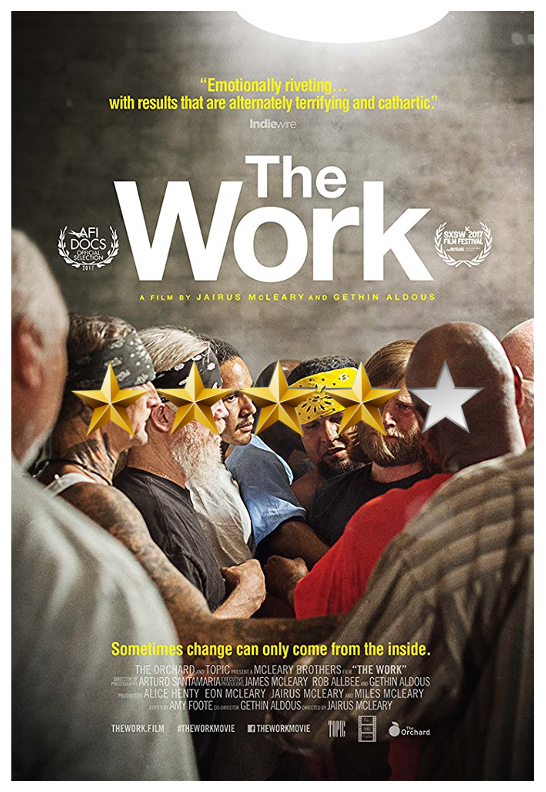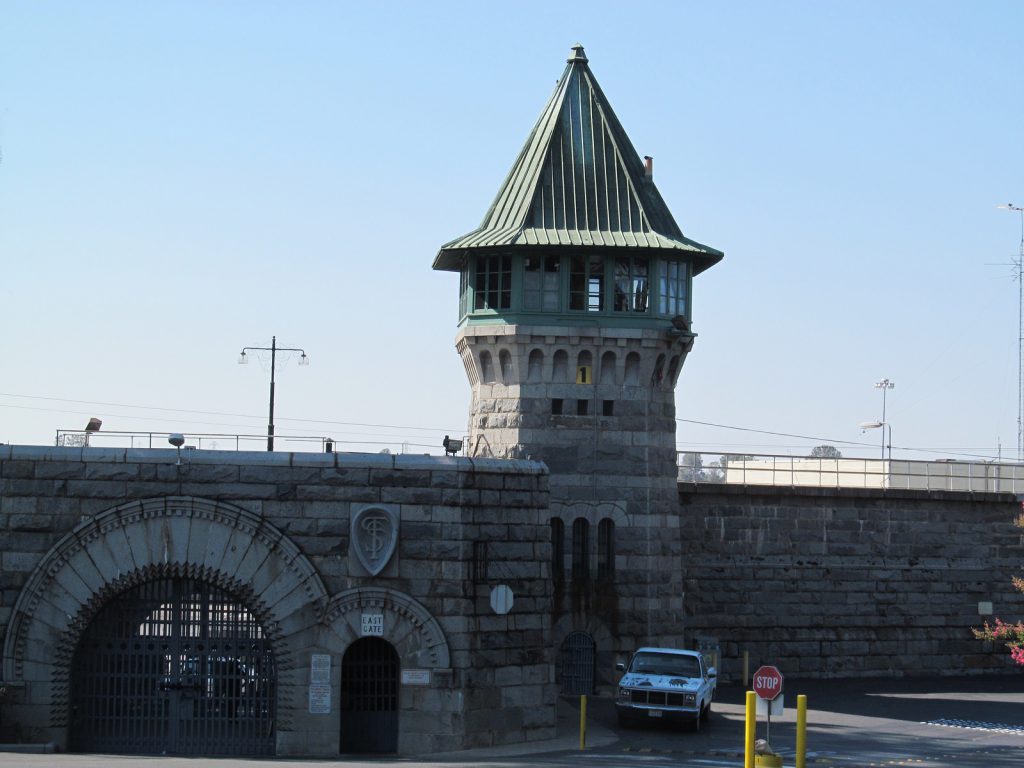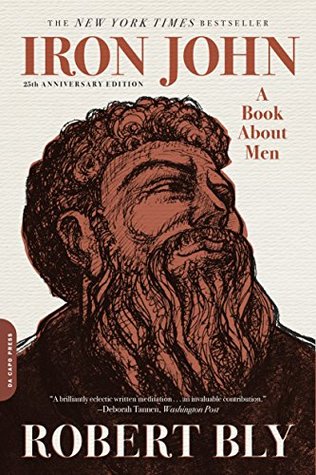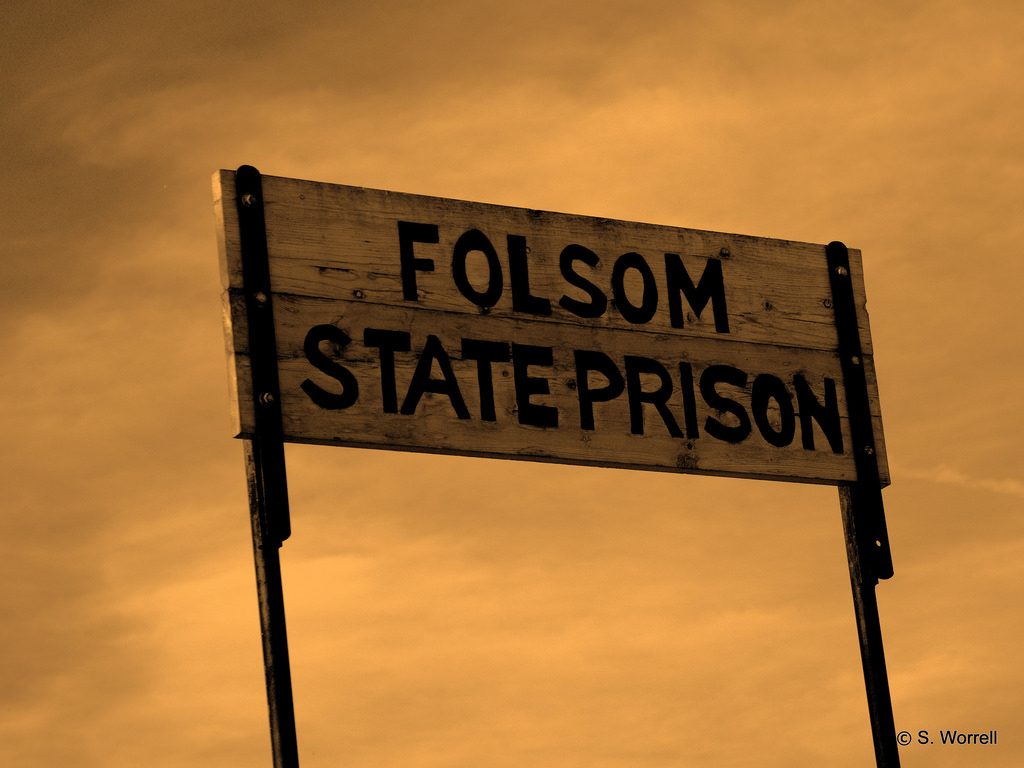Carolyn Burdett on The Work (2017)
Carolyn Burdett on The Work (2017)
I’ve been interested in psychoanalysis for a long time. Freudian psychoanalysis, like literature, is committed to words, supremely interested not only in what is said but also in how it gets said. For Freud, the bodily symptom that makes people unwell is a form of articulation that can’t find its way into words. Finding those words and having them heard is what psychoanalysis is all about. That may be why I am invariably resistant to therapies that actively involve bodies. But I am having to rethink after watching The Work (2017) by Jairus McLeary and Gethin Adous.
 The Work (2017) promotional image [Image used under fair dealings provisions]
The Work (2017) promotional image [Image used under fair dealings provisions]
The Work is a documentary about a psychotherapeutic programme for prisoners at Folsom State Prison in California. Twice yearly, members of the public – all men – join inmates for four days in the prison, and the work of the film’s title is the intensive group therapy undergone by the men in these mixed groups. The Work is McLeary’s first film and it won the Grand Jury prize for Best Documentary Feature at South by Southwest Film Festival. We’re informed at the start of the film that McLeary has attended the programme for several years – and that’s not surprising as it is hard to imagine how this piece of film-making could have happened unless the men involved trusted those holding the camera.
Folsom State Prison is California’s second oldest prison, admitting prisoners from 1880, and it houses Medium Security male inmates. Originally built for men serving very long sentences, its history was punctuated from the outset with violence: riots, escapes, and the deaths of inmates and staff. If you’ve heard of Folsom, it might well be from Johnny Cash’s 1957 ‘Folsom Prison Blues’.
 Folsom State Prison [Image by Vince under a CC BY-NC license]
Folsom State Prison [Image by Vince under a CC BY-NC license]
Formally, the film doesn’t innovate much: we’re led in from outside, on each of the four days of the programme, following the men as they are driven to the prison grounds through sparse Californian landscape and brilliant blue skies. Sometimes the camera focuses on an object – wheat waving in the wind – gently reminding us of what the men inside the prison don’t see. The men from outside are warned on first entering the prison perimeter to be absolutely quiet and remember that they are entering a ‘maximum security’ institution and are ‘being watched right now’. As maybe forty or so of them file in they look like a convict line except that they are dressed in clothes that mark them as people from a world where you choose and buy your own jeans and T-shirt. ‘Inside’ is a large room identified as the chapel by a sign on the door. Early on, we see momentarily a cameraman, with a hand-held camera, moving around the men who gather in a large circle in the room. The observing eye of the documentary isn’t entirely hidden but mostly it’s unobtrusive. The only other device is written information shown on screen – including names and sentence terms, and notes about involvement in gangs and violence. The participants are mic’d so we hear those we follow clearly in an overall soundscape that is often filled with shouts, cries and screams.
The film focuses on three of the ‘men from outside’, Charles, Chris and Brian. Each visitor has to choose two guides from amongst the ‘guys who have to wear blue’ who have been attending therapy and are experienced. We are told that for the programme’s four days the convicts agree to suspend the gang politics and the racial segregation of the yard. Soon we’re into introductions, as Charles, Chris and Brian select their guides. The camera rolls us around the newly constituted groups of three, tuning into the first hesitant questions – ‘What are you looking for from this experience?’; ‘What goes on in the prison yard?’ – pausing to hear Rick, the terrifying-looking, tattooed, neck-braceleted, bandana-wearing member of the Aryan Brotherhood (America’s oldest white supremacist prison gang) report that he’s there for ‘one count of murder, three counts of robbery’, and that he’s served 22 years; or Dark Cloud, from the Skins Native American prison gang, who relates to a blank-faced blinking Chris the horrifying act of violence that took him to Folsom. Brian, who cannot meet the eyes of the two prisoners who sit intently focusing upon him, asks defensive and slightly aggressive questions about prison life. He learns that Vegas, one of his guides, former Shot Caller for The Bloods gang, has been attending the therapy sessions for four years, has 70-years-to-life for ‘kidnapping for the purposes of robbery’, and has been in Folsom for 19 years. One man explains he entered on a robbery charge aged 18 and is still there aged 39.

Folsom State Prison [Image by rocor under a CC BY-NC license]
Then the ‘therapy’ begins in earnest. The men break into small groups of about twelve, and each is invited in turn to speak about why he is participating, or to recall a significant memory. One speaker becomes the focus and is encouraged to bring to the fore hidden and taboo feelings – to ‘go down’, to ‘get close to the wound’. It’s a group cathartic method of therapy that encourages the men to expose their neediness, weakness or pain, and then supports them as they reencounter associated feelings. The first full scene we witness involves Kiki, a member of the Pacific Islander and Asian Prisoner gang, who is attending therapy for the first time, yearning but unable to mourn his dead sister.
Watching this scene I thought I might switch off. Later – after I couldn’t get the film out of my head – I realized that my visceral dislike for group therapies involving men getting physical with each other and shouting and screaming has an origin (though perhaps not the deepest) in the ‘Iron John’ phenomena of the early 1990s associated with the American poet, Robert Bly. Iron John was a bestselling self-help book aimed at the generation of men hurt by the Vietnam war and its aftermath. Iron John in mythology is the hairy ‘wild man’, the brave and wise warrior. Bly is in a long line of men who mourn modernity’s assault on an idealized masculinity and I found his book repugnant, a creepy call to American men to go out into the wilderness to bare their chests together and moan about how uppity feminists diminished them.
 Iron John cover [Image used under fair dealings provisions]
Iron John cover [Image used under fair dealings provisions]
The scenes we witness in The Work contain much that I objected to in the 1990s – including the failure to articulate and avow how women suffer at the hands of men (women are almost entirely absent in this film). However, two things differ: the first is the prison context, and the second is the convicts themselves who, somehow – astoundingly – have developed extraordinary skills as therapeutic practitioners. It’s astounding because the environment is so terrible: dark, scary and depressing, as Charles forcefully notes. As the co-founder Rob tells the group, there are ‘intense, dedicated, committed’ men amongst them prepared to go as far as needed. And he’s right. These men are skilled not only in what they say and feel, but also in how they use their bodies – bodies that codify masculinity, aggression and violence but in this space are put to very different uses.
Kiki fears the loss of ‘my armour, my vest’ should he approach the sadness of his sister’s death. As the men gather round, chanting ‘feel it, give it up’, one steps forward, asking permission to touch Kiki on the jaw, instructing ‘relax your jaw, relax your jaw’. He strokes Kiki’s jaw, gentle but persistent, until at last a sob vomits from Kiki: ‘there it is’, the men call, as he falls to the ground. What we witness next is distressing – as is so much in this film – as Kiki screams and fights on the floor. But the men move themselves around him – Kiki is tiny, while most of them are massive – huge bodies ballast and protect, lying against him. ‘We’ve all got your back’, someone calls: ‘I’m right here with you brother’, says another. It is an overwhelming lesson in the difference of bodily choreography in the acts of restraining and holding: the men ‘hold’ Kiki, contain him, in the therapeutic sense that the psychoanalyst Donald Winnicot theorized as the ‘holding environment’ that allows the child to develop and experiment in safety. Kiki, the men, and we as viewers, emerge shaken, exhausted – and helped. ‘Good work, man’, Vegas says, as he and Kiki look at each other, ‘naked man’.
 Folsom State Prison sign [Image by Stephen Worrell under a CC BY-NC license]
Folsom State Prison sign [Image by Stephen Worrell under a CC BY-NC license]
The narrative drive of the film is focused on the three men who are temporary visitors and their stories are fascinating. For me, though, the standout scene in the film involves prisoners. Its two central figures are Vegas and Dante, a young black man serving two life sentences plus 55 years. This encounter takes place on Day 3, the hottest day, when the men sweat and fan themselves, stripped to their vests in the enclosed space. Dante is speaking about the overwhelming distress of no longer seeing his son: his once-partner no longer visits. Eventually, speaking in a flat voice, Dante says that there is too much pressure and, if he were to die, no one would know and no one would care. This prison is not working, he says, and he does not wish to live. Men wipe their sweating faces and stay silent; Dante’s cheek has a tear slowly rolling down it. Eventually, another man sits down next to him, putting his arm around him and explaining that it is ‘not often someone takes me to a place I don’t know where to go. I’m sorry’. Charles suddenly erupts about how terrible prison is until, eventually, he breaks down, weeping and begging Dante not to give up. At that point, Vegas stands and tells Dante to stand too. The two men face each other, very close, as Vegas berates him: ‘That shit is bullshit, and you know it; […] Grow the fuck up […] Do you hear me? Do you hear me?’ By this time the men are so close, absolutely still, their heads inches away from each other. Moments pass in intolerable tension: two huge men eyeball to eyeball and the possibility of horrific violence is frightening. But they are also almost mouth to mouth and the erotic potential of a kiss is palpable. As the moments pass another tear slides down Dante’s face. Vegas asks: ‘Do you feel me?’ and the men clasp each other, so close you can no longer discern their words which are muffled and replaced by the sound of their hearts beating – fast and then slowing. Sub-titles give us the words as Vegas requests a reprieve from Dante before acting on his self-destructive urge, begging for three months, for 90 days. Dante at first tells him: ‘I can’t give you that, man’. But Vegas persists: give me it, give me it and, at last, Dante agrees, and the men clasp again, this time weeping from somewhere else.
Vegas returns trembling and exhausted to his chair. One of the facilitators encourages the men to stand up and to ‘feel what happened’. Rick, the Aryan Brotherhood convict, bursts into what was, for me, one of the film’s most compelling moments. Here, in the aftermath of the physical encounter between the two black men, Rick gives out a howl of pain. He is tired, he says, of people getting hurt, tired of the blood. As others try to reassure him that the blood can be washed off, he screams at Dante: ‘Why can’t we be enough to hang onto? Why can’t I be enough?’ Here, in this terrible place, amidst men who have made misery of their own and others’ lives, have formalized racial hatred and antagonism, this is a call that asserts the value of human love – and a claim to something like family.
 The Work (2017) [Image used under fair dealings provisions]
The Work (2017) [Image used under fair dealings provisions]
The Work left me with an intensified sense of the grim failure of the US prison system, and the even grimmer social realities that lead men there. Towards the end of the final day, one of men talks about fatherless sons: I was a fatherless son, he says; my father was a fatherless son, and my sons were fatherless until I changed myself. The final information we have on the screen is that over its 17 years of running 40 men engaged in the therapy have been released and none has reoffended. That is an unusual recidivism statistic but – according to the Bureau of Justice Statistics – there is a prison population of over two million people. Most of the men we see in this film won’t get out. The film doesn’t invite complacency – or even much hope. 40 men in 17 years. This is slow work, and hard work. But it is extraordinary work, reminding us that, though words are the weft of our human existence, sometimes they fail. We need bodies to be intelligent and timely and loving too.
*
The Work had a limited film release in October this year; it’s available to buy or rent from iTunes; in November it showed on BBC4 and was available on BBC iplayer.